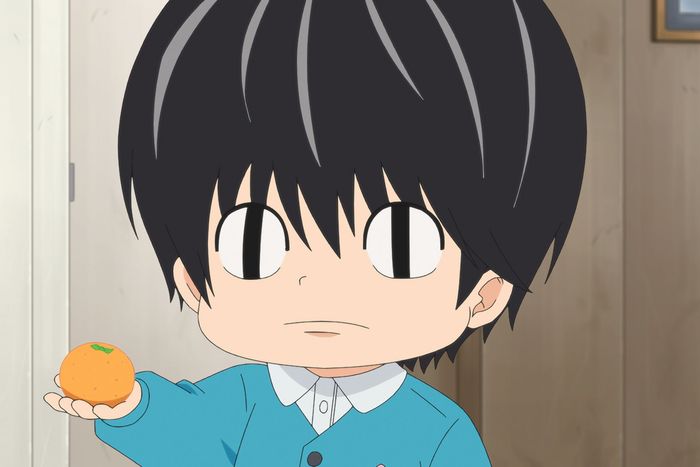
Kotaro Sato, the 4-year-old main character of Kotaro Lives Alone, is not like other kids. It’s obvious from the eyes. They’re appropriately anime sized, only his irises run vertically in two thick rectangles like train tracks laid through his face — adorable and disconcerting. He wears a red-and-white T-shirt with a gold star that says “GOD” and keeps a toy sword at his hip, just like Tonosaman, a samurai who slays evil mushrooms in an anime only Kotaro seems to love. Like his button-faced hero, Kotaro lives by a righteous code of conduct and speaks in the cadences of feudal Japan, addressing people as “Sir” and “Lady.” Most distressing: Kotaro lives alone.
This unease hangs in the background for the entirety of the ten-episode Netflix anime adaptation of a 2015 manga written and illustrated by Mami Tsumura. There’s a less successful live-action version from last year that casts the anime’s beauty in greater relief; animation is forgiving and expansive in a way that live-action is not, allowing the suspension of disbelief needed for Kotaro to hit a very precise tone that lives somewhere between the sweetness of a reality show like Old Enough, which sends toddlers out on errands, and the devastation of the World War II drama Grave of the Fireflies. The scale here is smaller but no less existential: What happens to latchkey kids who are abandoned by their parents, whether literally or figuratively, and find ways to self-soothe? How do children deal with loss? And most affectingly, what makes a family?
We first meet Kotaro in the supermarket looking for tissues. He declines the kids’ brand three-pack with dinosaurs and grizzly bears wearing top hats. No, he tells the employee, he wants the practical economy boxes: housewarming gifts for each of the residents in the small building complex he has moved into. Karino, his next-door neighbor, a struggling manga artist, answers the door and looks down to see little Kotaro handing him the tissues. “I thought this apartment didn’t allow tenants with kids?” he asks. “I don’t have any kids living with me,” Kotaro replies.
Kotaro and Karino form the classic odd couple as inverse configurations: the precocious child and the adult baby. Kotaro is financially stable; Karino is unsuccessful. Kotaro is clean and organized; Karino can’t remember the last time he bathed. And yet in the way of children, Kotaro forces Karino to think about someone other than himself for a change. Karino begins to chaperone Kotaro, and the 4-year-old becomes the nucleus that pulls the other building’s tenants together. All implicit outsiders, Mizuki, a hostess at a salon, takes on a maternal role, while Tamaru, a yakuza in his full purple leopard-print suit, melts into baby talk whenever he sees the child. Everyone comes from their own fragile family units, and like a Hirokazu Kore-eda film, the building’s residents form a makeshift community around Kotaro, accompanying him on errands, having sleepovers, and attending his kindergarten ceremonies. Routine and structure expand around him like an airbag. Eventually Karino becomes more of an adult, which allows Kotaro to act more like a kid.
Kotaro follows the rhythm of daily life, its humor deadpan. Each episode is made up of short, sometimes disconnected vignettes that feel like paging through a scrapbook: Kotaro has a cold; Kotaro makes bento lunch boxes at the convenience store; Kotaro scams someone for free balloons. There is a resistance to explaining too much; the lack of clear episodic arcs makes each beat spontaneous. Feelings will catch a character like an undertow. We don’t understand the full contours of how Kotaro came to live by himself, but eventually we get snatches, often from a throwaway comment or idiosyncratic behavior. The stories take on a poetic, parable-like quality. There’s a scene when Kotaro starts an umbrella-sharing service in which he walks commuters home on rainy days with an umbrella (he attaches it to his sword to lengthen it). When a new building resident, Sumire, notices that Kotaro’s own shoulders are getting soaked throughout the night, he explains how this is the proper method. The umbrella should always shield the other person. A wet shoulder shows you care.
Kotaro subverts the abandoned-child trope that exists in so much anime — the superpowered boys and magical girls who go on fantastical adventures to other dimensions in an ultimate wish fulfillment of independence. Kotaro doesn’t dodge the inherent darkness of the premise — why is a child living alone? — but also imagines an informal family structure in which the parental bond is one made over time rather than assumed. In Kotaro, the ephemera matters — the small gestures and quirks. Love is showing up for school recitals and washing someone’s hair. It is a daily practice. “Even if it’s just for now, I decided that I would keep track of his day-to-day life,” Karino explains to a perplexed adult. “Those memories are proof of living.”
There’s a running joke within the show that Karino’s manga editor doesn’t like his drawing style because it’s “too old-school.” Like its subject, the animation of Kotaro is simple and effective. The aesthetic evokes childhood without being childish — the bright, bold strokes reflect Kotaro’s own absurdly frank worldview. Memories take on a hazy, disjointed quality. Kotaro’s biological parents appear with heavy brows, like curtains drawn over their eyes. Then there are moments when the usually stoic Kotaro is moved and small white pupils appear in his eyes like stars punching through a night sky.

